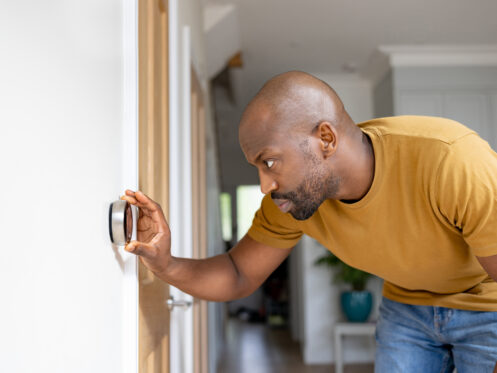You rely on your thermostat to provide a true temperature reading at all times. However, you might have noticed discrepancies. Maybe you’ve noticed the reading being a bit higher or lower than you think it should be. Perhaps you’ve even used a secondary thermostat to confirm that there’s an issue. Let’s explore some of the most common causes for unreliable temperature readings.
Dirty Thermostat Contacts
Digital thermostats have contacts between the control board and faceplate. Dust and other debris can accumulate on the contacts and disrupt the electrical signals. These disrupted signals can lead to inaccurate readings. One reason to schedule seasonal tune-ups is that they include thorough thermostat cleaning.
Incorrect Calibration
If you have an older analog thermostat, ensure that it’s level. An unlevel thermostat will provide an incorrect reading due to the mercury inside. All thermostats can lose their original calibration over time due to normal aging, power fluctuations, and dust. Most thermostats have an offset system. This allows you to adjust the displayed temperature by the necessary degrees for accuracy. Older thermostats provide manual adjustment, whereas programmable and smart thermostats often provide software-based adjustment.
Software and Configuration Errors
Programmable and smart thermostats are advanced devices with control boards, firmware, and software. It’s possible that incorrect user input or corrupted data could be the cause. Often, the easiest remedy is to power cycle the thermostat. If that doesn’t work, that unit may require a factory reset. Some thermostats offer a manual option while others require you to do it through the software settings. When factory resetting, it may be important to back up settings and ensure compatibility with connected systems. In that case, consider calling for professional for help. An HVAC technician can also update firmware and help program software.
Faulty Temperature Sensor
Most modern thermostats use a thermistor to read temperatures, and they degrade over the years. It may get to the point where offsetting it is no longer practical, or it may fail outright. Typically, replacing just the thermistor is not cost-effective, which makes full thermostat replacement the more practical solution.
Low Battery Power
Low battery power can result in an irregular electrical signal, should you have a unit that uses batteries for backup or normal operation. That can manifest in a wide range of odd behaviors, including inaccurate readings. If this is the case, replacing the battery with a fresh one should do the trick. Frequent battery issues may require professional service. Fast battery draining, in particular, may suggest an issue with wiring or the thermostat itself.
Faulty Wiring
A bad wire or electrical connection can result in irregular electrical signals as well. In this case, you’ll need a technician to replace the bad wire or connection. With some smart thermostat setups, it may be the C-wire adapter that requires replacement. When a home lacks the necessary C-wire, and adapter is an alternative to installing it.
Suboptimal Installation Location
Most thermostats for the home have an integrated temperature sensor. That means the position of the thermostat itself is very important, and a central location is ideal. A thermostat near heat sources like kitchens may give inaccurate readings. Another common issue is sunlight through a window. That will heat the thermostat and increase the temperature reading. One solution is to move the thermostat to a better location.
An alternative solution is to invest in a smart thermostat that supports remote temperature sensors. With remote sensors, the position of the thermostat itself is unimportant. Temperature sensing in multiple areas of the home provides a more accurate reading overall.
Uneven Heating or Cooling
Airflow issues, especially warm spots near a sensor, may provide a reading that doesn’t accurately reflect what you’re experiencing. Keep all vents open and as many doors open as possible. Use ceiling and other fans wherever practical to improve circulation. Every couple of years, schedule a duct inspection, or schedule now if you have significant airflow issues. Your system may need duct cleaning, duct sealing, or full system balancing.
Professional Thermostat Services in Douglas and Beyond
Serving Douglas, GA, and the surrounding areas since 1959, Chancey Heating & Cooling is a family-owned business dedicated to providing quality HVAC services. We offer a wide selection of top-brand thermostats, including programmable and smart models, and provide comprehensive services such as cleaning, calibration, programming, and software updates, alongside our expert HVAC installation and repair.
Contact us today online or by phone with any thermostat questions or to schedule an appointment.

